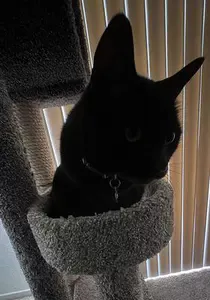What Is Feline Hyperesthesia Syndrome?
Feline hyperesthesia syndrome or FHS is a condition with an array of symptoms, including tail chasing, affecting house cats of any age. It's more commonly seen in one to four year old cats, and kitties of certain breed heritage.
I was prompted to look into this disease when one of our readers, Mike, asked about his cat's odd tail chasing behavior. I had heard of FHS, but I never really made a personal connection until I started reading about it. More on that, and why observation is critical below.
What's Here
Symptoms and signs
Causes
Video showing mild signs
Video showing more severe signs
Many a house cat will have the occasional fight with the tail. They'll chase the tail, grab it with the paws, possibly bite it, or perhaps just spin round and round and never really get a hold of it.
Some cat owners think it's cute or interesting behavior, but it may indicate a problem. Tail chasing may be the result of a behavior problem, or it may be from a physical problem, such as pain or discomfort in the back or tail area.
Here's a video showing a cat displaying mild feline hyperesthesia syndrome symptoms. Notice the twitching of the legs and the skin on the back, as well as the frantic licking and body movements. This cat has fairly subtle symptoms, but this one has more severe symptoms.
Note: This cat's "strange behavior" was initially diagnosed as feline hyperesthesia, but later, was diagnosed with Inflammatory Bowel Disease.
If your cat exhibits odd behaviors, hisses and chases her tail, acts aggressive, or repeats frantic licking or excessive grooming behavior, it may be FHS.
Your veterinarian will want to rule out a neurological disease, injury or infection, spinal tumor, or other medical cause.
While tail chasing behavior is just one of the clinical signs, it's important to note if your cat engages in this activity, how often, and what other signs of the syndrome your cat may display. A symptom list is below.
As I mentioned above, my research into this disease made me realize a personal connection. I firmly believe, after learning more about this disease, that Priscilla had it, although not in a severe form. I missed it simply because I didn't know what to look for, and didn't connect all the dots.
She had hyperthyroidism and hypertrophic cardiomyopathy, that much is known, and I attributed her odd behaviors to that. But, I didn't realize her other behaviors must have been more than just the thyroid or not feeling right.
Her tail chasing was periodic and didn't seem extreme, and I never connected it with her other symptoms. I'm pretty observant, and a very concerned cat parent, and I still missed the connection. Lesson learned.
I need to take my own advice on how important it is to pay attention to your cat's normal behaviors and regular routines, so that you'll know when something is truly wrong. Personality changes are evident in cats when they're ill, but we tend to ignore repeated subtle signs over time and say, oh she's just being a cat.
I also always stress the importance of being sensitive to the fact that cats like a routine, and anything that disrupts that routine can bring on or worsen behavioral or medical problems.
That includes permanent or temporary changes in living arrangements and housemates, or even a change in your daily routine, such as waking up at a new time and going to a new job.
The breeds feline hyperesthesia is more commonly seen in are the Siamese, Burmese, Himalayan, and Abyssinian. It's possible that this is because these cats are more type A personality cats, and therefore prone to react to stress.
Himalayans tend to me more laid back, though, so my only guess would be the Siamese in them is at fault. But that's amateur guessing on top of speculation.
Siamese, by the way, are also very commonly afflicted with wool sucking behavior. So hide your sweaters from the meezers!
Signs and Symptoms
Feline hyperesthesia signs and symptoms include:
- Behavioral and personality changes
- Biting
- Dilated pupils
- Excessive grooming (sometimes resulting in hair loss)
- Frantic licking/chewing
- Hissing
- Running
- Seizures
- Self-mutilation
- Skin ripples or "rolling skin"
- Tail chasing
- Tail swishing
- Vocalizations or hypervocalization
Cats afflicted with this condition may seem open to company one minute, and then begin biting or thrashing the next. They may seem calm, and then make a mad dash out of the room, or begin running in circles.
The cat in the video below has his nasty face on. He was eventually diagnosed with feline hyperesthesia and put on medication, after which his symptoms stopped...
Causes
Possible causes include:
- Behavioral problems
- Skin conditions, including food allergies, flea allergy dermatitis, or infectious skin diseases
- Neurological disorders, including brain tumors, or injury or disease to the spine, including tumors or infections
Treatment will include treating the underlying disease if one can be found, or drug therapy, such as phenobarbital.
Even if your cat's tail chasing is only occasional, you should mention it to your vet at checkups, so you and your vet can keep an eye on things.
Vetinfo.com mentions that prevention includes maintaining a high quality diet and reducing stress levels.
A reader on this site claims that symptoms improved after switching to a grain free cat food.
Feline hyperesthesia is also called rolling skin syndrome, self-mutilation syndrome, hyperkinesis, atypical neurodermatitis, and twitchy cat disease.
Note: There are two videos posted here that are meant to be illustrative of signs and symptoms, but I have not had confirmation that these cats actually do have feline hyperesthesia syndrome. Like other complex veterinary diagnoses, only a veterinarian can confirm a diagnosis.


Comments: What do you think?
Have your say about what you just read. Leave me a comment in the box below.